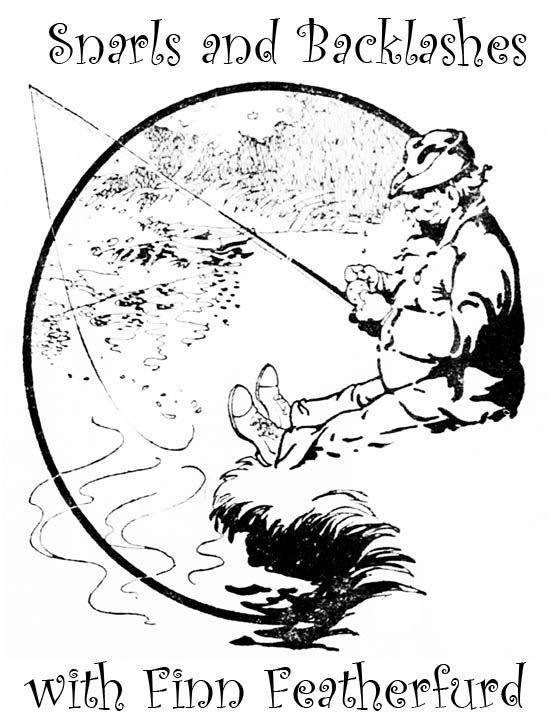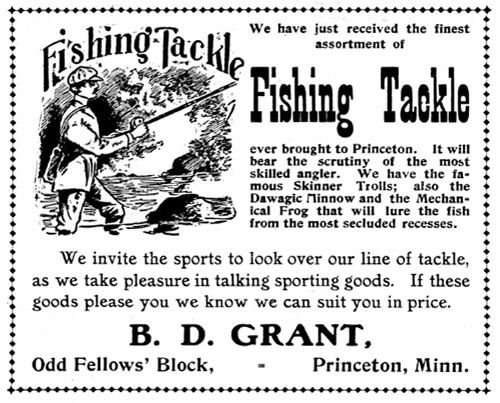
When I approached Todd about subjects to write on for his blog, one thing he suggested was I do something with newspapers and fishing. As a former columnist for several big papers, I learned the inside workings of the paper business, and I've always had a soft spot for them. So I thought about it, and keeping with the theme of the Fishing for History blog, I suggested I pen my first series of articles about one of my favorite subjects: old newspaper ads.
Yes, newspaper ads. To be more specific, newspaper ads hawking FISHING TACKLE. And yes, I'm aware that Wild Bill Sonnett does a weekly column on fishing tackle ads -- and I might add does them better than me, or anyone else on this green earth, could hope to do. Seriously folks, you ought to be carving a statue of Sonnett out of marble for all the pearls of wisdom he's dropped into your unsuspecting laps. There isn't a single episode of Deconstructing Old Ads that doesn't have multiple revelations in it. I couldn't hope to reproduce that kind of success in my wildest dreams.
So I'm going to take a different tack.
As a lover of newsprint I have always been fascinated by pictorial advertising, which really became popular in papers around 1900 and reached its apex in the '20s and '30s. While most of us are used to seeing the great magazine tackle ads ala Larry Smith (a reference you young 'uns are likely to miss), papers carried a lot of wonderful pictorial advertisements. Take for example the ad below for B.D. Grant from the May 24, 1906 Princeton (Minnesota) Union. You know what I like about this?

Every single God damn thing. Can I say God damn? I guess I'll know if it gets published. Let's start with the image. Classic turn-of-the-century (and not this lame 2000 b.s. either) styling when men fished in jackets with jaunty caps. And that mustache, neatly groomed. I'm sure this fine angling gentleman rode a velocipede to the babbling brook.
He's baitcasting for trout, by the way, which would certainly make the fly fishing zealots (like our dear blog owner) faint dead away, tut-tutting as they gently swoon to the ground, careful not to harm their $2000 bamboo fly rods. I never could figure out why it's OK to spin or baitcast for every fish on earth except trout. One of my favorite things to do is find a pod of "fly anglers" as they like to call themselves and cast a Mepps right between them from the other side of the stream.
Don't get me wrong, I love fly fishing, but it's just another way to catch a fish. No better or worse than any other, and despite what the Gingriches and Halfords say, not any more ethical either. But I digress.
Let's look at the text of the ad. Skinner Trolls, "Dawagac" Minnows, Mechanical Frogs…I'm getting excited thinking about it. If I were reading this over morning coffee in the summer of 1906 you can be damn sure I'd beat a hasty path with my horse-and-buggy down to B.D. Grant's shop; Even the address--Odd Fellows' Block--is just perfect.
Over half a continent away, the following year the Hauser brothers, presumably Germans of good, solid stock, of Salem, Oregon were putting together their own tackle ad, run in the April 22, 1907 issue of the Salem Daily Capital Journal.

It's certainly a different idea on how to run a tackle ad, along the lines of "throw everything including the kitchen sink" at the reader. It does have a nice pictographic header, but the crux of the ad is all about shoving as much tackle down your throat as will fit. Whereas Mr. Grant was content to titillate with his "Dawagac" minnow literary references, the Hausers depict a Colorado spinner, a H.J. Frost automatic fly reel, the "Yellow King" fly and a trunk rod (7 pieces mean a hell of a lot of ferrules and the action of a dead branch). Fortunately the 010 rod shown was only $3. I'm sure it made for excellent kindling.
The "Yellow King" intrigues me most. I did a Google search for it but gave up after about a minute as I was inundated with slightly disturbing links. Ah the internet. You're always only a click away from your eyeballs boiling in their sockets. Anyway, I'd love to know what the "Yellow King" looked like. It looks too big to be a dry fly, probably not a wet either. Likely either a bass fly or streamer…
The Hauser brothers should have taken a lesson from the Salt Lake Hardware Company. The ad below, dated June 24, 1916 and run in the very Mormon-y Salt Lake newspaper Goodwin's Weekly, is a perfect newspaper ad. Well, it should be, considering the paper it was run in billed itself as "A thinking paper for thinking people."

What's not to like? A beautiful piece of "Silhouette" art. Again, a pair of sharply dressed anglers, a snappy fly rod and reel, and a pipe to lend a touch of elegance. "From the very lightest and most delicate fly casting equipment up to heavier, sturdier tackle for lake fishing…" Not much more needs to be said here.
More so than even Mr. Grant's ad (and certainly more than the Hauser brothers), THIS ad makes me want to go fishing. It makes me want to buy fishing tackle, also. And THAT'S what a good newspaper ad is supposed to do.
We'll jump into some more classic newspaper ads next week.
-- Finn
Finn Featherfurd is the pseudonym of a sad and lonely retired professor and newspaper columnist who has spent the better part of the past four decades (unsuccessfully) chasing fish in the Lower 48. A long-time collector of vintage fishing tackle of all kinds, he is currently fascinated by pre-1920 children's fishing reels (40 yards and smaller). When the spirit moves him, he will contribute occasional pieces and essays to the Fishing for History Blog. He can be reached at finnfeatherfurd@yahoo.com.
No comments:
Post a Comment